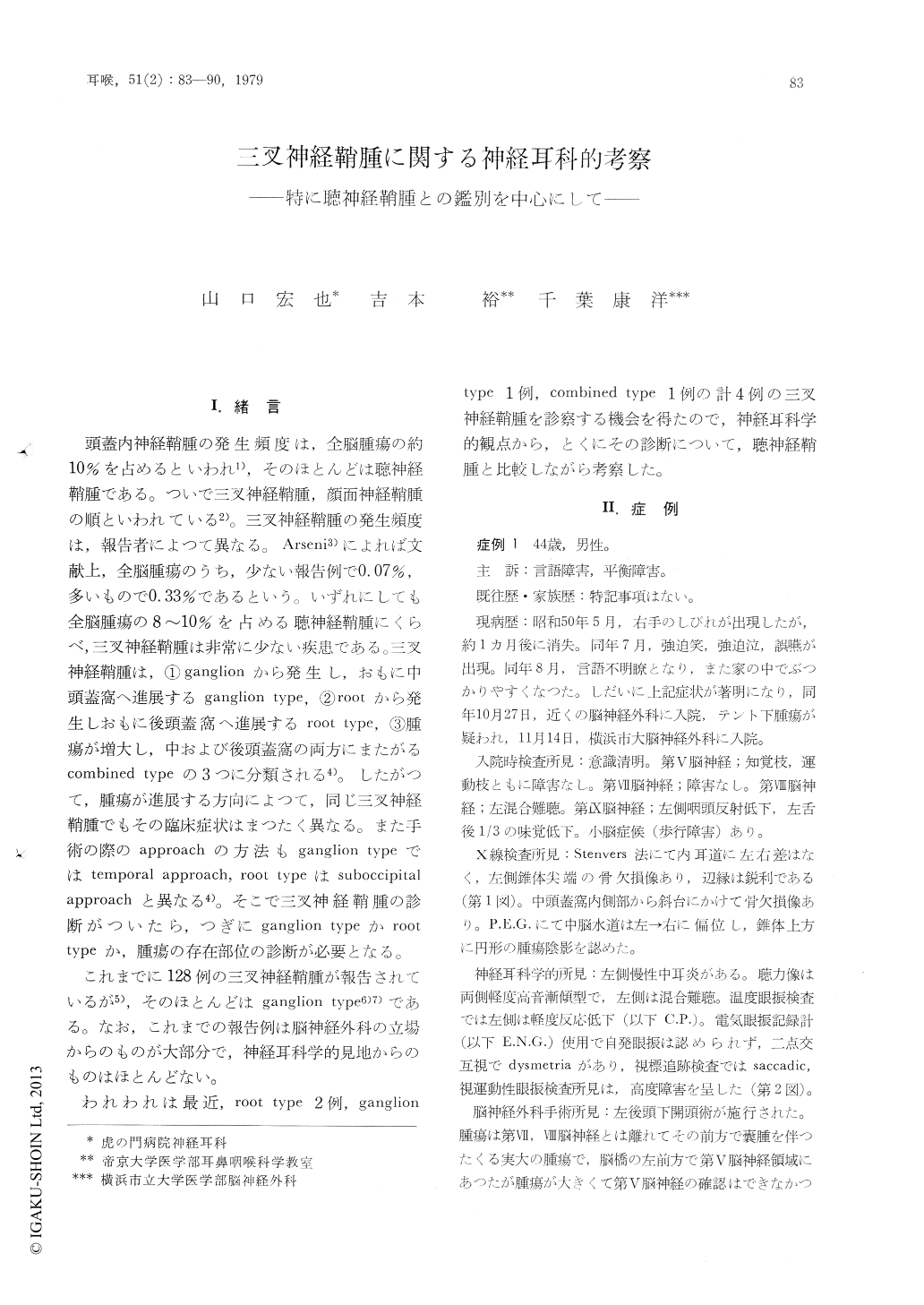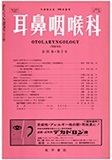Japanese
English
- 有料閲覧
- Abstract 文献概要
- 1ページ目 Look Inside
I.緒言
頭蓋内神経鞘腫の発生頻度は,全脳腫瘍の約10%を占めるといわれ1),そのほとんどは聴神経鞘腫である。ついで三叉神経鞘腫,顔面神経鞘腫の順といわれている2)。三叉神経鞘腫の発生頻度は,報告者によつて異なる。Arseni3)によれば文献上,全脳腫瘍のうち,少ない報告例で0.07%,多いもので0.33%であるという。いずれにしても全脳腫瘍の8〜10%を占める聴神経鞘腫にくらべ,三叉神経鞘腫は非常に少ない疾患である。三叉神経鞘腫は,①ganglionから発生し,おもに中頭蓋窩へ進展するganglion type,②rootから発生しおもに後頭蓋窩へ進展するroot type,③腫瘍が増大し,中および後頭蓋窩の両方にまたがるcombined typeの3つに分類される4)。したがつて,腫瘍が進展する方向によつて,同じ三叉神経鞘腫でもその臨床症状はまつたく異なる。また手術の際のapproachの方法もganglion typeではtemporal approach,root typeはsuboccipitalapproachと異なる4)。そこで三叉神経鞘腫の診断がついたら,つぎにganglion typeかroottypeか,腫瘍の存在部位の診断が必要となる。
これまでに128例の三叉神経鞘腫が報告されているが5),そのほとんどはganglion type6)7)である。なお,これまでの報告例は脳神経外科の立場からのものが大部分で,神経耳科学的見地からのものはほとんどない。
Neurinoma of the trigeminal nerve is very rare. It is classified into three groups depending on the anatomical location of the tumor : 1) in the middle fossa-ganglion type 2) in the posterior fossa-coot type 3) in both middle and posterior fossae-combined type. More than 120 cases have been reported in the literature, but most of them have been discussed from the neurosurgical standpoints, and there are a few that have been discussed by neurotological aspect.
As we recently experienced four cases of trigeminal neurinoma : two cases of root type, one of ganglion type and one combined type, we discussed the characteristics obtained by neurotological studies in comparison with those in acoustic neurinomas.
The summary is as follows. 1) In a ganglion type there were no neurological signs except for increased intracranial pressure.
2) Impairment of hearing was noted in two cases. In one case suffered from chronic otitis media, it was undetermined whether the mild impairment of hearing was due to the compression of the VIIIth cranial nerve or not. Two cases showed mild impairment in caloric test. Extensive abnormalities were usually noted in caloric test in most acoustic neurinomas. Hearing test and caloric test were important to differentiate trigeminal neurinomas from acoustic neurinomas.
3) Gaze nystagmus test, positional nystagmus test and positioning nystagmus test were also important to differentiate trigeminal neurinomas from acoustic neurinomas. In the former cases these tests revealed relatively mild impairments in spite of large tumors. Eye tracking test and optokinetic nystagmus test, however, demonstrated no characteristic findings in comparison with acoustic neurinomas.
4) Plain skull x-rays revealed smooth and well-delineated bony defects at the petrous apex in three out of four cases.
5) The tumor of ganglion type was hen egg sized, and two tumors of the root type were walnut sized.
The tumor of the combined type was bigger than walnut.

Copyright © 1979, Igaku-Shoin Ltd. All rights reserved.


